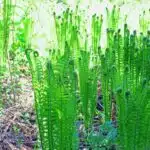Macho ferns, also known as Nephrolepis biserrata, are a popular indoor and outdoor plant that can add a touch of greenery to any space. These ferns can grow up to four feet tall with their lacy fronds spreading wide, making them an ideal centerpiece for a garden or patio. However, growing and caring for these plants requires some knowledge and expertise.
As a horticulturalist, I have worked with various kinds of plants and have found that the macho fern is one of the most rewarding plants to cultivate. The key to successfully growing these ferns is providing them with the right soil conditions, temperature, water, and light. In this article, I will share my insights on how to grow and care for macho ferns so that you too can enjoy their beauty in your home or garden.
Understanding Macho Ferns: An Overview
Macho ferns are a unique and vibrant addition to any garden or indoor space. They are known for their large size, reaching up to three feet tall and four feet wide, as well as their thick, lush fronds that can span up to six feet in length. These ferns have a distinct appearance that sets them apart from other fern varieties. The fronds of macho ferns are bright green, leathery, and can grow up to two inches wide.
One of the benefits of owning macho ferns is that they are relatively low maintenance compared to other plants. They thrive in shaded areas with moist soil and require minimal watering. Macho ferns also help purify the air by absorbing pollutants such as formaldehyde and xylene. Additionally, they provide a pop of color and texture to any space they occupy.
Compared to other fern species like Boston or Maidenhair Ferns, macho ferns can grow much larger and have thicker leaves. They also require less light than some other varieties making them an excellent choice for indoor spaces where natural light may be limited. Macho ferns are also more tolerant of drought conditions, making them ideal for those who may forget to water their plants regularly.
Choosing The Right Soil For Macho Ferns
Choosing the right soil for macho ferns is crucial to their growth and overall health. The best soil for these plants must be rich, well-draining, and provide adequate moisture retention. Macho ferns thrive in a soil mix that consists of equal parts peat moss, perlite, and vermiculite.
Soil amendments can also significantly improve the quality of the soil. Adding organic matter such as compost, aged manure or leaf mold will enhance the soil’s nutrient content and structure. These amendments will also increase water-holding capacity in sandy soils or drainage in heavy clay soils.
It is important to avoid using garden soil or topsoil when planting macho ferns as these types of soils may contain pests, diseases or weed seeds that can harm your plant’s growth. Instead, opt for high-quality potting soils specifically formulated for indoor plants or container gardening. In the next section, we will discuss how to properly pot and repot your macho fern to ensure its longevity and healthy growth.
Potting And Repotting Macho Ferns
As we have discussed in the previous section, choosing the right soil is crucial in ensuring the proper growth and health of your macho ferns. However, it is equally important to consider repotting frequency and potting materials. Repotting should be done every two to three years or when you see that the roots are starting to outgrow their container. This will give the roots more space for growth and prevent them from getting too cramped.
When repotting, it’s best to use a high-quality potting mix that is well-draining but retains enough moisture to keep the fern hydrated. A mix of peat moss, perlite, and vermiculite is an excellent choice as it provides good drainage while also holding onto moisture. Avoid using heavy soils such as garden soil or clay as these can cause waterlogging which can lead to root rot.
It’s also important to choose the right size of pot for your macho ferns. A pot that is too small can stunt its growth while a pot that is too large can make it hard for the plant to absorb nutrients effectively. The best way to determine this is by choosing a container that’s one size up from its current pot, not more than that. By following these steps, you can ensure your macho ferns thrive in their new home. In the next section, we’ll discuss watering dos and don’ts for your macho ferns.
Watering Macho Ferns: Dos And Don’ts
Proper watering is essential for the growth and well-being of macho ferns. The frequency of watering depends on various factors, such as the size of the pot, humidity levels, and temperature. It is recommended to water your macho fern once or twice a week during the growing season, and reduce watering during winters when the plant goes dormant.
Overwatering can cause root rot and other fungal diseases in macho ferns. Therefore, it is crucial to ensure that the soil moisture level is appropriate before watering. You can do this by sticking your finger about an inch deep into the soil; if it feels dry, it’s time to water your plant. Also, make sure to use well-draining soil and pots with drainage holes to prevent water from accumulating at the bottom.
Proper watering habits are crucial for maintaining healthy macho ferns. By following these simple steps, you can avoid overwatering and ensure that your plants receive just the right amount of moisture they need to thrive. In the next section, we will discuss light requirements for macho ferns and how you can provide adequate light for their growth.
Light Requirements For Macho Ferns
Like all ferns, macho ferns require the right amount of light to grow and thrive. Imagine that light is like food for plants: just as we need a balanced diet to stay healthy, so too do plants need a balance of different types of light. For macho ferns, the ideal lighting conditions will depend on whether they are grown indoors or outdoors.
If you’re growing macho ferns indoors, it’s important to place them in a bright spot where they can receive plenty of indirect sunlight. Direct sunlight can scorch their leaves and cause damage over time. If you don’t have access to natural light, artificial lighting can be used instead. Full-spectrum LED lights are an excellent choice for indoor macho ferns because they mimic natural sunlight and provide the right balance of warm and cool tones.
For outdoor macho ferns, it’s best to place them in a partially shaded area where they can receive dappled sunlight throughout the day. Too much direct sunlight can dry out their fronds and cause discoloration. However, if your area has hot summers or strong afternoon sun, you may want to consider providing some shade with a canopy or umbrella. This will help regulate the amount of light that reaches your plants and prevent them from getting overheated.
When it comes to lighting requirements for macho ferns, there are several factors to consider depending on whether they are grown indoors or outdoors. By providing the right amount of light – whether that’s through natural sunlight or artificial lighting – you can ensure that your macho ferns grow healthy and strong. In the next section, we’ll discuss temperature needs for these beautiful plants and how you can keep them at their best year-round.
Temperature Needs For Macho Ferns
Macho ferns are known for being hardy plants that can tolerate a wide range of temperatures. However, they do have an ideal temperature range that will help them thrive. The optimal temperature for macho ferns is between 60 and 75 degrees Fahrenheit. This temperature range provides the perfect environment for the plant to grow and flourish.
It’s important to note that while macho ferns can tolerate fluctuations in temperature, drastic changes can have a negative impact on their growth. If the temperature drops too low or rises too high, it can cause damage to the plant. It’s best to keep your macho fern in a location where the temperature remains relatively consistent throughout the day and night.
If you live in an area with extreme temperatures, you may need to take extra precautions to protect your macho fern. For example, if you live in a region with hot summers or cold winters, you may want to move your plant indoors during these seasons. This will help ensure that your macho fern stays within its ideal temperature range and continues to thrive.
Moving onto fertilizing macho ferns…
Fertilizing Macho Ferns
Just as the temperature is a crucial factor in determining the growth and health of macho ferns, so is fertilization. To keep your macho ferns looking lush and vibrant, it is essential to provide them with proper nutrients. Fertilizer helps to replenish the soil with necessary minerals that may have been depleted over time, ensuring that your ferns have all they need to thrive.
When it comes to selecting the best fertilizers for your macho ferns, there are several options available. One of the most popular choices is a balanced, slow-release fertilizer. These types of fertilizers are great for providing a steady stream of nutrients to your plants over an extended period. Alternatively, you can also opt for organic fertilizer or liquid fertilizer if you prefer more natural options.
To ensure that your macho ferns receive adequate nutrition throughout their growing season, it’s important to establish a fertilizing schedule. Typically, fertilizing every two weeks during the spring and summer months will suffice. However, be sure not to over-fertilize your plants as this can lead to nutrient burn and adversely affect their growth. By following a regular fertilizing schedule using appropriate products, you can help your macho ferns reach their full potential and remain healthy throughout their lifespan.
As important as feeding is pruning and trimming macho ferns. Removing dead or yellowing fronds and stems promotes new growth while preventing fungal infections from damaging healthy foliage. In addition, trimming back any overgrown areas will help maintain an attractive appearance for these impressive plants. But before we delve into pruning techniques in detail let us first understand some basic facts about Macho Ferns’ foliage structure and habituation tendencies.
Pruning And Trimming Macho Ferns
Pruning techniques are essential in maintaining the health and vitality of macho ferns. Pruning not only helps to remove any dead or damaged fronds but also promotes new growth by stimulating the plant’s natural branching process. It is important to prune regularly, especially during the growing season, when the fern is actively producing new fronds. When pruning, always use clean and sharp tools to prevent damaging the plant further.
Trimming frequency varies depending on the size and growth rate of your macho fern. Generally speaking, it is best to trim your fern once every two months to control its size and shape effectively. If your fern is growing at a fast pace, you may need to trim it more frequently. On the other hand, if your fern is not growing as quickly, you can reduce trimming frequency accordingly.
In summary, pruning and trimming are vital aspects of caring for macho ferns properly. Regular pruning helps keep your fern looking healthy and lush while promoting new growth. Determining how often to trim depends on factors such as growth rate and desired size and shape of the plant. By following these guidelines, you can ensure that your macho fern thrives for years to come.
Moving forward into dealing with pests and diseases requires an understanding of common issues that can affect macho ferns’ health. Proper pest management techniques will be discussed in detail in the next section.
Dealing With Pests And Diseases
Insects such as aphids, whitefly, spider mites, and mealybugs can all cause damage to Macho Ferns, making it important to inspect the plant on a regular basis.
Fungal infections are also common in Macho Ferns, especially when the environment is too humid and air circulation is poor.
To prevent these issues, Macho Ferns should be grown in an area with indirect sunlight and good air circulation, and watered only when the soil is partially dry.
Additionally, it is important to regularly remove any dead or damaged foliage to reduce the risk of pests and diseases.
Insects
Insects are a common problem when growing macho ferns. Some of the most common pests include spider mites, mealybugs, and scale insects. These insects can cause damage to the plant by sucking sap from the leaves and stems, which can lead to wilting and yellowing of the foliage. It is important to identify these pests early on and take action immediately.
One effective way to deal with insect infestations is by using natural remedies. For instance, spraying the affected plants with a mixture of water and neem oil can eliminate many types of insects. Additionally, introducing natural predators such as ladybugs or lacewings can help control insect populations. Another option is to use insecticidal soap, which is made from natural ingredients such as potassium salts of fatty acids.
Chemical treatments should be used as a last resort when dealing with insect infestations in macho ferns. While they may be effective in eliminating pests quickly, they can also harm beneficial insects and pollinators in the process. Moreover, repeated use of chemical treatments can lead to resistance among insect populations, making them more difficult to control in the future. Therefore, it is important to exhaust all other options before resorting to chemical treatments when caring for macho ferns.
Fungal Infections
Fungal infections are another common problem that can affect macho ferns. These infections can be caused by a variety of fungi, including Rhizoctonia and Pythium. Fungal infections can cause black spots or lesions on the leaves or stems of the plant, and in severe cases, can lead to the death of the plant. Prevention techniques such as proper watering and good ventilation can help reduce the risk of fungal infections.
If a fungal infection does occur, there are several treatment options available. One option is to remove infected leaves or stems immediately to prevent the spread of the fungus. Additionally, applying a fungicide such as copper sulfate or sulfur can help control fungal populations. However, it is important to follow instructions carefully when using these chemicals to avoid harming the plant or other beneficial organisms.
In conclusion, preventing and treating pest and disease problems in macho ferns requires careful attention and proactive measures. Using natural remedies and methods should always be considered before resorting to chemical treatments. By staying vigilant and taking action early on, gardeners can help ensure their macho ferns remain healthy and vibrant for years to come.
Propagating Macho Ferns: Step-By-Step Guide
As horticulturalists, we know that pest and disease management is essential for the healthy growth of any plant. In this context, it is crucial to mention that macho ferns are relatively resistant to pests and diseases. However, they can still be affected by spider mites, scale insects, and mealybugs. To prevent such infestations, ensure that you keep your ferns well-watered and avoid over-fertilizing them. Macho ferns thrive in damp soil conditions with partial or filtered sunlight.
Macho fern propagation is a rewarding experience for any plant enthusiast. The ideal time to propagate these ferns is during spring or early summer when the temperature is warm enough for the plant’s growth. Start by selecting a healthy frond from your mature macho fern and place it into a container filled with moist soil mixtures. Keep the soil moist but not waterlogged until you notice new growth emerging from the frond. You can then transplant it into a larger pot or outdoor garden.
Caring for macho ferns requires attention to detail because they are sensitive to their environment. Ensure that you provide adequate water levels and misting regularly to maintain high humidity levels around your plants. Fertilize your macho fern once every two months using balanced liquid fertilizers to promote healthy growth. These care techniques will help keep your macho ferns lush and vibrant throughout their lifespan in your garden or landscape design project. In the next section, we will explore using macho ferns in landscaping as an effective way to enhance any outdoor space.
Using Macho Ferns In Landscaping
Macho ferns are a popular choice for landscape design due to their large size and vibrant green foliage. These ferns thrive in outdoor environments with consistent moisture and partial shade. When used in landscaping, macho ferns can add an element of texture and height to garden beds or serve as a statement piece on a patio.
Incorporating macho ferns into outdoor decor can be done in various ways. One option is to plant them in clusters along the edge of a garden bed, creating a natural border. Another option is to use them as a backdrop for smaller plants or flowers, highlighting their grand size and unique shape. Macho ferns can also be planted in tall pots and placed on either side of an entryway, making for an impressive entrance.
When using macho ferns in landscape design, it is important to consider their maintenance requirements. These plants need ample water, especially during hot summer months, but do not tolerate standing water. They also benefit from regular fertilization to ensure healthy growth. With proper care and attention, macho ferns can be a stunning addition to any outdoor space.
| Sun Exposure | Soil Type | Watering Needs |
|---|---|---|
| Partial Shade | Well-draining soil | Consistent moisture |
Table 1: Optimal conditions for growing macho ferns outdoors
| Landscape Design Ideas |
|---|
| Plant in clusters for natural borders |
| Use as backdrop for smaller plants or flowers |
| Plant in tall pots for impressive entrance |
Table 2: Creative ways to incorporate macho ferns into outdoor decor
Growing macho ferns indoors: tips and tricks will explore how these plants can thrive inside the home environment with the right conditions and care.
Growing Macho Ferns Indoors: Tips And Tricks
With their bold and lush foliage, Macho ferns can make a stunning addition to any interior space. When considering indoor placement for your Macho fern, it is important to choose an area that receives bright, indirect light. Direct sunlight can scorch the plant’s leaves, while too little light can cause them to become leggy and sparse.
One of the key factors in successfully growing Macho ferns indoors is humidity control. These tropical plants thrive in high humidity environments, so be sure to mist them regularly or place them near a humidifier. If you’re struggling to keep up with the humidity demands of your plant, consider setting up a pebble tray filled with water beneath its pot. This will create a small microclimate around the plant and help to maintain consistent moisture levels.
By following these tips and tricks for growing Macho ferns indoors, you’ll be well on your way to enjoying this beautiful plant in the comfort of your own home. However, if you’re looking for even more ways to care for your ferns and help them thrive, be sure to read on for our expert advice on growing Macho ferns outdoors.
Growing Macho Ferns Outdoors: Tips And Tricks
Outdoor Placement: Macho ferns are ideal for outdoor placement, as they thrive in the humid climate of tropical regions. When choosing a location to plant your fern, make sure that it is not exposed to direct sunlight as this can cause the fronds to burn and dry out. Instead, choose a spot that receives partial shade or dappled sunlight. Additionally, ensure that the soil is well-draining and rich in organic matter.
Shade Requirements: As mentioned earlier, macho ferns require partial shade or dappled sunlight to grow healthily. However, too much shade can also be detrimental to their growth. If your fern gets insufficient light, it may become leggy and produce fewer fronds. Therefore, it is best to place your macho fern in an area with filtered light where it will receive 2-3 hours of direct sunlight daily.
Table:
| Outdoor Placement | Shade Requirements |
|---|---|
| Choose a spot that receives partial shade or dappled sunlight. | Ensure that the fern receives 2-3 hours of direct sunlight daily. |
| Make sure that the soil is well-draining and rich in organic matter. | Too much shade can cause leggy growth and fewer fronds. |
Common Mistakes to Avoid: To ensure the healthy growth of your macho ferns outdoors, avoid planting them in areas with heavy foot traffic as this could damage their delicate root system. Additionally, overwatering can lead to root rot while underwatering may cause wilting and yellowing of leaves. To maintain optimal soil moisture levels, water your macho fern regularly but do not let the soil become waterlogged.
Transition: Avoiding common mistakes when growing macho ferns is crucial for their continued health and vigor. In the next section, we will discuss some common mistakes you should avoid when caring for these beautiful plants indoors.
Common Mistakes To Avoid When Growing Macho Ferns
Just as a ship needs to navigate through the rough sea to reach its destination, proper care and attention are critical when growing macho ferns. The journey may be challenging, but it is rewarding when done correctly. However, even with the best intentions, common mistakes can occur that can affect the health of your fern. As a horticulturalist and plant expert, I want to share some troubleshooting tips for avoiding these mistakes.
One of the most common mistakes people make when caring for macho ferns is overwatering them. These ferns prefer moist soil but not waterlogged roots. Overwatering can lead to root rot, which can be fatal for any plant. To avoid this mistake, ensure that the soil is well-draining and allow the top inch or two of soil to dry out before watering again.
Another mistake people make is placing their macho fern in direct sunlight. While they require bright light to grow properly, too much direct sunlight can scorch their delicate foliage. Instead, place them in an area where they receive filtered light or partial shade. Doing so will keep them healthy and vibrant.
In conclusion, growing and caring for macho ferns requires patience, attention to detail, and understanding their specific needs. By avoiding these common mistakes and following our troubleshooting tips for keeping your fern healthy, you will have a thriving plant that adds beauty and elegance to your space. Next up are frequently asked questions about macho ferns that may help you along your journey towards becoming a successful gardener!
Frequently Asked Questions About Macho Ferns
Macho ferns are a popular choice for those looking to add some greenery to their indoor or outdoor space. As with any plant, there may be questions about how to care for them. Here are some frequently asked questions about macho ferns.
One common question is how to propagate macho ferns. They can be propagated through division, which involves separating the root ball of an established plant into smaller sections and planting each section in its own pot. Another method is through spores, which can be collected from mature fronds and planted in a moist growing medium. It’s important to note that propagation can take time and patience, but it can be rewarding to watch your new plants grow.
Another question often asked is how to incorporate macho ferns into landscaping ideas. These ferns work well as focal points in larger landscape designs or as part of a grouping of plants with similar light and water requirements. They also look great when placed in large containers on patios or decks. The key is finding the right balance between the size of the plant and the space available.
In conclusion, proper propagation techniques and strategic placement in landscaping designs can help ensure the success of your macho ferns. With proper care, these ferns can thrive both indoors and outdoors, adding a lush touch to any space they inhabit.
Frequently Asked Questions
Can Macho Ferns Grow In Full Sun?
Growing macho ferns requires a delicate balance of environmental factors, including the proper amount of sunlight. These ferns thrive in bright, indirect light and can tolerate some direct sun exposure in the morning or evening hours. However, excessive exposure to full sun can lead to leaf scorching and other damage. To ensure optimal growing conditions for macho ferns, it is best to provide them with partial shade or filtered sunlight throughout the day. As a horticulturalist or plant expert, it is important to understand the nuances of each plant species and their unique needs for sunlight and other growing conditions. By taking these factors into account, you can help your plants thrive and serve others by providing healthy and beautiful greenery for their spaces.
How Often Should I Fertilize My Macho Fern?
Fertilizer frequency is a crucial aspect of maintaining the health and longevity of macho ferns. These plants require regular feedings to replenish their nutrient requirements, which vary depending on the growth stage and environmental conditions. As a general rule, it is recommended to fertilize macho ferns every 4-6 weeks during the growing season (spring and summer) with a balanced, water-soluble fertilizer. It’s essential to follow the manufacturer’s instructions for application rates and dilution ratios to avoid over-fertilization or nutrient burn. Additionally, it’s advisable to reduce the frequency and strength of fertilization in winter when the plant enters dormancy. Properly feeding your macho ferns will help them thrive and produce lush foliage that will beautify any space they occupy.
Can I Propagate Macho Ferns By Dividing The Plant?
Plant propagation is a common method used to grow and expand plant populations. While dividing the plant is a popular form of propagation, it may not always be the best option for certain species. For macho ferns, alternative methods such as spore propagation and tissue culture have been successful in producing healthy and robust plants. These methods require specific conditions and techniques, making them more challenging than simply dividing the plant. However, for those who are willing to put in the extra effort, these alternative methods can result in a larger and healthier population of macho ferns.
What Are The Most Common Pests That Affect Macho Ferns?
Macho ferns are vulnerable to insect pests like spider mites, mealybugs, and scale insects. Preventing infestations is the best way to protect these plants from damage that can impact their growth and development. Natural pest control methods using insecticidal soaps or neem oil can help eradicate these pests without harming the plant. It is important to regularly inspect macho ferns for signs of insect activity and take immediate action if any are detected. Treating the affected plant with natural pest control products will help prevent further damage and ensure healthy growth. In conclusion, by being vigilant in monitoring pests and utilizing natural pest control methods, macho ferns can thrive in optimal conditions.
Do Macho Ferns Require A Specific Ph Level In Their Soil?
Maintaining the appropriate pH level of soil is crucial for the growth and development of Macho Ferns. These plants require a slightly acidic soil with a pH range between 5.5 to 6.5, which helps in maintaining the nutrient uptake and water absorption capacity of the plant. Changes in soil acidity may lead to stunted growth and yellowing of leaves, indicating nutrient deficiencies or excesses. To ensure optimal growth, regular monitoring of soil pH levels is necessary, and adjustments can be made by adding organic matter or using fertilizers that promote acidification. Additionally, watering frequency should be adjusted accordingly to prevent fluctuations in pH levels caused by over-watering or under-watering. As horticulturalists or plant experts, it is our duty to provide the best care for these plants by ensuring they have an adequate environment for optimal growth and survival.
Conclusion
Macho Ferns are a beautiful addition to any garden or home, with their large fronds and lush green foliage. They can thrive in a variety of conditions, including full sun, as long as they are given enough water and protection from extreme heat. Fertilize your Macho Fern regularly with a balanced fertilizer to keep it healthy and vibrant.
Propagation of Macho Ferns is easy through division, which should be done in the spring or early summer. The most common pests that affect these ferns include spider mites and mealybugs, which can be treated with insecticidal soap or neem oil. It is important to maintain the proper pH level in their soil, which should be around 5.5-6.5 for optimal growth.
As horticulturalists, we understand the importance of nurturing and caring for our plants. A Macho Fern is like a child – it needs attention and love to grow strong and healthy. Just like how we provide our children with the right environment and nourishment to help them flourish, we must also provide our plants with the right conditions to thrive.
In conclusion, growing and caring for Macho Ferns is not difficult if you follow these simple guidelines. With proper care, your fern will reward you with its beauty for many years to come. Remember to treat it like family – give it love and attention, and watch it grow into a magnificent specimen that will bring joy to all who see it.
Image Credits





























